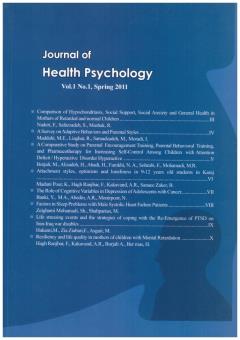Resiliency and life quality in mothers of children with Mental Retardation. Authors: (Farrokh Haq Ranjbar / Alireza Kakavand / Ahmad Borjali / Hamed Barmas)
Subject Areas : People with special needs Health Psychology
Keywords: resiliency, quality of life, mental retardation.,
Abstract :
Abstract The main purpose of this study was to examine the relationship between resiliency and quality of life in mothers of children with mental retardation. In this study, 60 mothers of female children with mental retardation in 3 educational area in Karaj were randomly selected in cluster and evaluated the resiliency scale Connor-Davidson(CD-RISE) and quality of life (QOL). The research method was descriptive correlational study, in which the results revealed positive and significant correlations (r=0.84) between resiliency (M=52.7, Sd=16.5) and quality of life (M=14.5, Sd=20.8),as well as positive and significant correlations between resiliency and components of quality of life (general health, physical health, family interaction, being parent, support associated with the common, spirited and cultural life, leisure and public awareness) In addition, results indicated that there was a significant positive relationship between resiliency and quality of life and its subscales .
منابع
بشارت، م. ع. (1386). تاب آوري، آسيب پذيري و سلامت رواني. مجله علوم روان شناختي، 24، 83-73.
كربلايي شيري فرد، ر. (1385). ساخت و هنجاريابي پرسشنامه اي براي اندازه گيري كيفيت زندگي خانواده هايي با فرزند كم توان ذهني. پايان نامه كارشناسي ارشد رشته سنجش و اندازه گيري. دانشگاه علامه. پايان نامه چاپ نشده. دانشكده روان شناسي و علوم تربيتي.
Alvord, C. B., Bcgar & Diana, H. (2006). Resiliency Determinats and resiliency processes armong female adult surnivors of childhood sexual abuse.
Bonanno, G.A. (2004). Loss. Trauma, and human resilience. American psychologist, 59, 20-28.
Carle, A. C., & chassion, L. (2004). Resilience in a community sample of children of alcoholies: its prevalence and relation internalizing symptomatology and positive affect. Journal of applied development psychology, 25, 577-596.
Connor, K. M. & Davidson, J. R.T. (2003). Development of new resilience scale: the connor- Davidon, Resilience scale (CD-RISC). Depression and anvety, 18, 76-82.
Hanstad, B. (1999). The stability of quality of life experience in people with type 1 diabetesovero period of years. Journal of nursing vol. 12. No, 3. P. 192.
luthar, S.S., & cichiti, D. (2000). The construct of resilience. Implications for interventions and social policies. Development and psychology, 12, 857-885.
luthar, S.S., (2006). Resilience in development and psychology, pp. 739-795.
Masten, A. (2001). Ordinary magic: resilience processes in development. American psychologist, 56, 227-228.
Tugade, M.M. & fredrickson, B. L. (2004). Resilinet individuals use positive emotions to bounce back from negative emotional experiences. Jurnal of personality and social psychology, 86, 320-333.
Whooul Group (world Health organization Quality of life Group) (1993) study protocol for world health organization project to develop a quality of life assessment instrument (WHOQUOL) Quality of life Research 2, 153-9.

